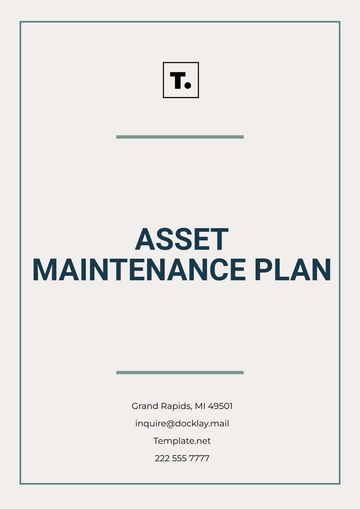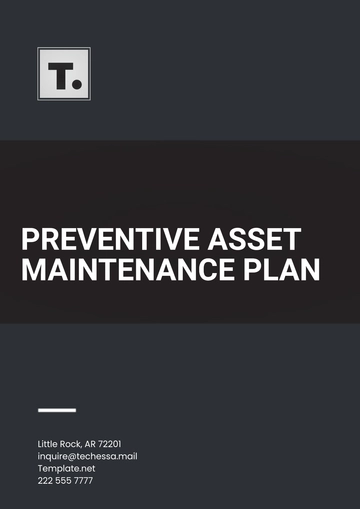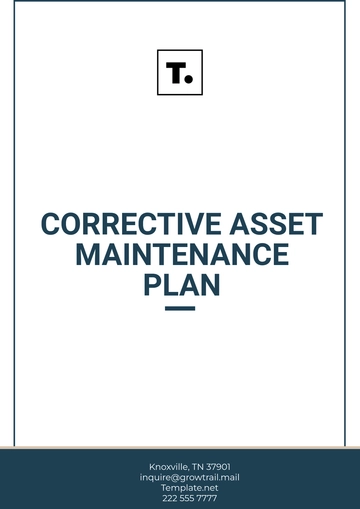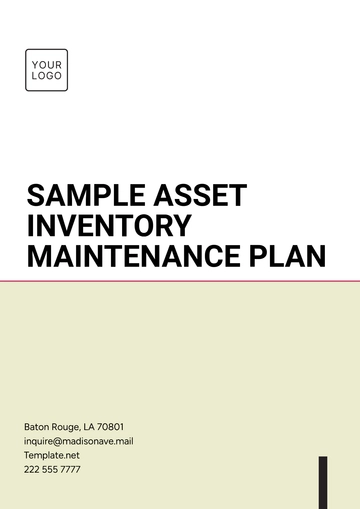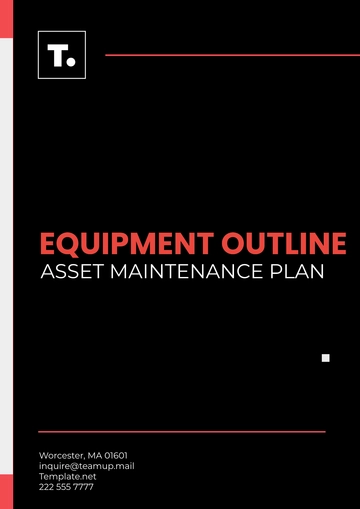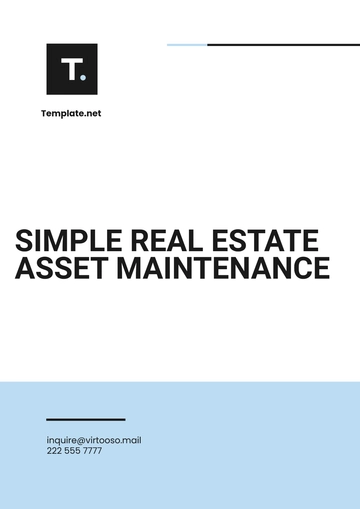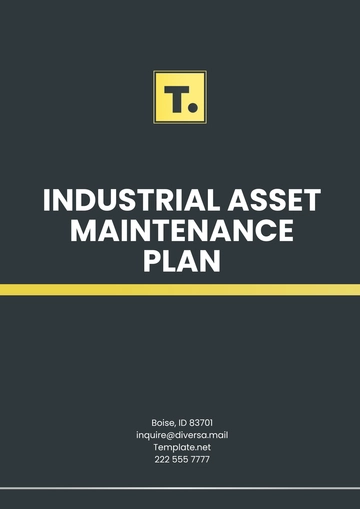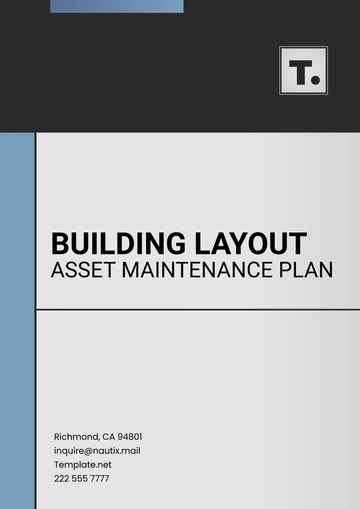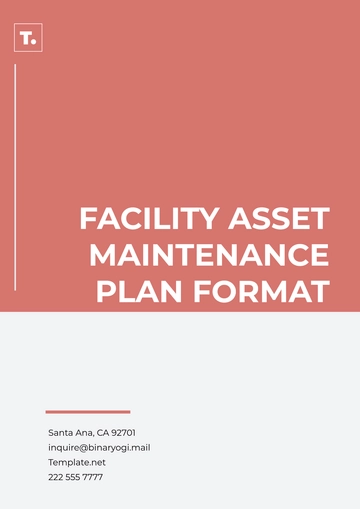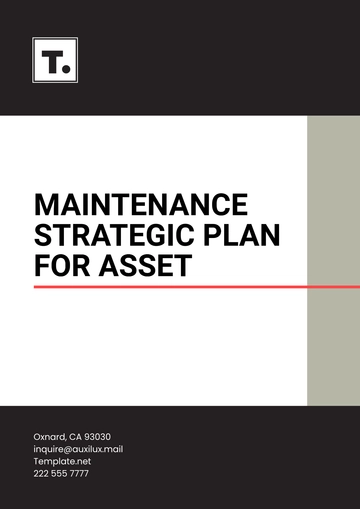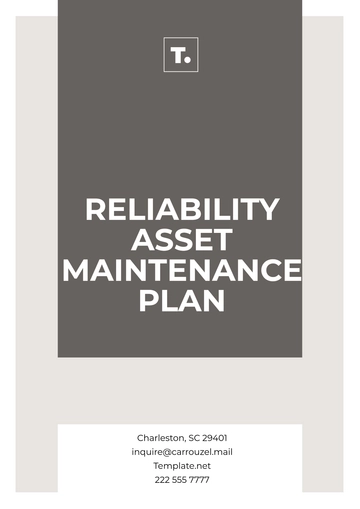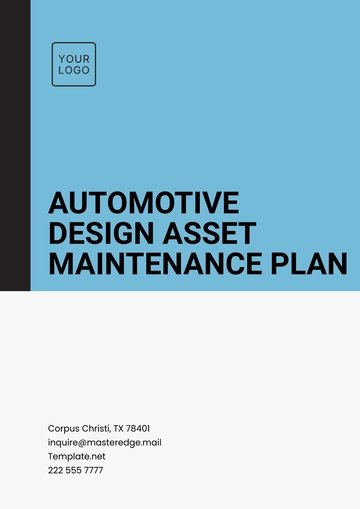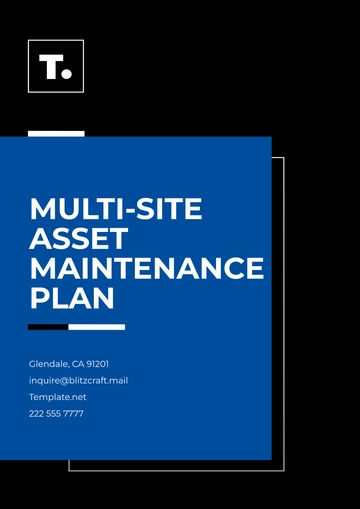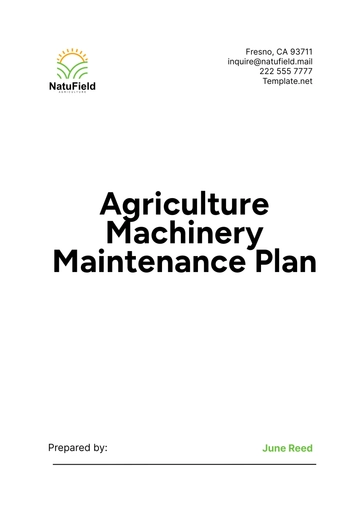Free Corrective Asset Maintenance Plan
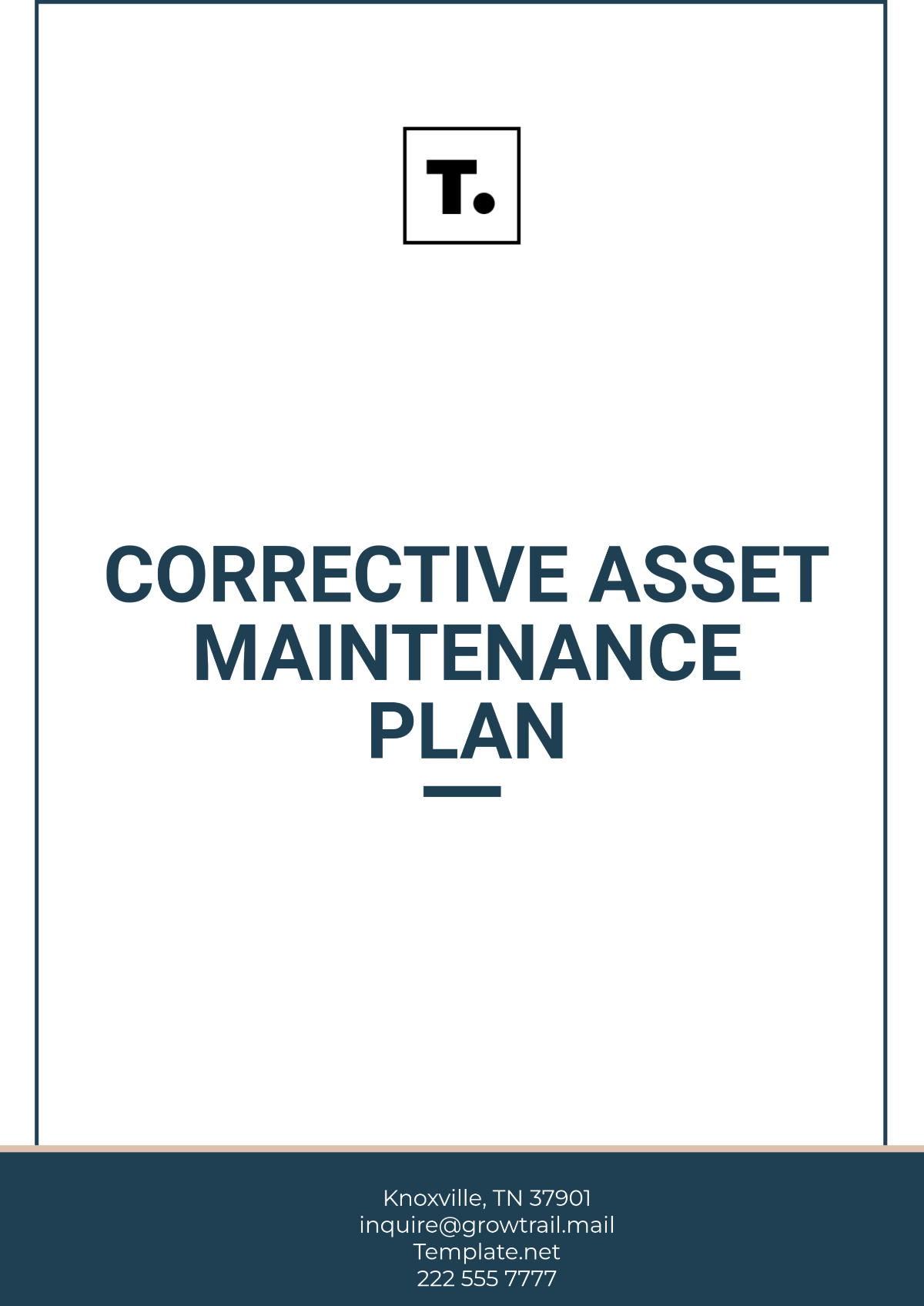
Prepared by: [Your Name]
Company: [Your Company Name]
Date: January 10, 2050
I. Introduction/Overview
This Corrective Asset Maintenance Plan is created to provide a structured approach to addressing the issues and failures that may occur in the company’s machinery and equipment. The objective is to ensure all assets perform optimally by identifying potential problems early and executing corrective measures such as repairs or replacements. This approach not only restores functionality but also maximizes asset lifespan, enhancing overall operational efficiency.
The plan includes identifying issues, diagnosing problems, outlining corrective actions, and specifying the resources, timeline, budget, and follow-up activities. Ensuring proper maintenance will help minimize unplanned downtime, reduce costs, and maintain a high level of productivity across the organization.
II. Problem Identification
Identifying equipment and machinery failures at an early stage is crucial to preventing more significant disruptions. The process involves systematic monitoring and assessment to detect irregularities or failures that may affect the performance of assets.
A. Equipment Inspection
Routine equipment inspections should be conducted regularly. During these inspections, technicians should check for signs of abnormal behavior, such as:
Unusual noises or vibrations that suggest malfunctioning parts.
Temperature changes indicate overheating.
Performance degradation, such as slower speeds or inconsistent outputs.
These inspections can be scheduled at defined intervals or triggered by operational performance degradation.
B. Failure Reports
Failure reports generated by monitoring systems or employees are vital tools in identifying trends of recurring issues. These reports might indicate:
Recurrent failures in specific machinery or equipment.
Operational inefficiencies that could signal impending failure.
Recommendations for corrective actions based on earlier incidents.
By analyzing these reports, teams can focus on areas that need immediate attention and allocate resources efficiently.
III. Diagnosis
Once an issue is identified, it is crucial to conduct a thorough diagnostic process to determine the root cause of the failure. Effective diagnosis will lead to targeted corrective actions and help prevent recurrence.
A. Root Cause Analysis
The root cause of a problem must be identified through an in-depth analysis. This can be achieved by:
Failure Modes and Effects Analysis (FMEA): Assessing each potential failure mode and its consequences on system performance.
Fault Tree Analysis (FTA): Breaking down the failure scenario into possible causes to find the underlying problem.
A detailed examination of the asset’s history and performance records can also provide insights into why specific components failed.
B. Diagnostic Testing
In this step, engineers and technicians will conduct diagnostic testing using both manual and automated tools. Tests might include:
Vibration analysis or thermal imaging to detect overheating or component stress.
Electrical tests to check for short circuits or malfunctions in electrical systems.
Structural inspections to identify cracks or weaknesses in mechanical components.
Accurate testing ensures a precise diagnosis and avoids unnecessary repairs.
IV. Corrective Actions
After diagnosing the problem, the next step is implementing corrective actions. This section outlines the approach to restore assets to optimal functionality.
A. Repair
Repairs should be performed on faulty components or systems identified during the diagnostic phase. This could involve:
Replacing damaged seals, bearings, or mechanical parts.
Repairing electrical connections or circuit boards.
Addressing misalignments or fluid leaks in machinery.
Timely and effective repairs prevent minor issues from escalating into major problems, ensuring continuity of operations.
B. Replacement
In cases where parts are beyond repair, replacement is the most effective corrective action. The process includes:
Sourcing parts from reliable suppliers to ensure compatibility and quality.
Replacing outdated or worn-out components that no longer meet operational standards.
Upgrading parts with newer, more efficient versions if available.
Replacement ensures that the equipment performs at peak levels, reducing the chances of further breakdowns.
V. Resources Needed
To implement the corrective actions effectively, certain resources are required. This section identifies the personnel, tools, and materials necessary to carry out the maintenance plan.
A. Personnel
The following personnel will be involved in executing the corrective asset maintenance plan:
Technicians: Conduct inspections, diagnostics, and repairs.
Engineers: Provide expertise in diagnosing complex issues and recommending long-term solutions.
Project Managers: Oversee the entire maintenance process, ensuring that timelines and budgets are adhered to.
Their combined efforts ensure that corrective actions are carried out efficiently.
B. Tools and Equipment
The necessary tools and equipment required for maintenance include:
Diagnostic Equipment: Thermal cameras, vibration analysis tools, and electrical testing devices.
Repair Tools: Wrenches, screwdrivers, welders, and other mechanical tools for fixing components.
Replacement Parts: Bearings, seals, electrical components, and other spare parts needed for repairs.
Having the right tools on hand is essential to minimizing downtime and ensuring repairs are completed effectively.
VI. Timeline
To ensure the corrective maintenance plan is executed on time, a clear timeline should be created. This timeline will help manage the workflow and ensure that tasks are completed as scheduled.
Phase | Duration | Description |
|---|---|---|
Inspection | 1 week | Initial examination of equipment to gather data. |
Diagnosis | 2 days | Assessment and determination of root cause. |
Corrective Actions | 2 weeks | Implementation of repairs or part replacements. |
Evaluation | 1 week | Post-maintenance testing and assessment. |
Each phase should have clearly defined milestones and deadlines to ensure all actions are performed efficiently.
VII. Budget/Cost Estimate
A comprehensive budget should be developed to account for the costs associated with the corrective maintenance activities. This ensures that the necessary funds are available to complete the maintenance process without delays.
Category | Estimated Cost |
|---|---|
Labor | $12,000 |
Parts | $6,500 |
Tools | $3,000 |
Miscellaneous | $1,200 |
This budget estimate includes labor charges for technicians and engineers, the cost of replacement parts, tools, and any additional resources required to complete the corrective actions.
VIII. Follow-up and Evaluation
After corrective actions have been implemented, it is crucial to assess the effectiveness of the repairs and ensure the asset is functioning as expected.
A. Performance Monitoring
Performance metrics will be used to evaluate the success of the corrective maintenance. These metrics could include:
Equipment uptime or production output.
Operational efficiency post-repair.
Energy consumption or material usage rates.
Continuous monitoring helps detect any lingering issues and ensures optimal asset performance.
B. Follow-up Inspections
Scheduled follow-up inspections should occur at set intervals (e.g., after one month, three months, and six months). These inspections ensure that:
The repairs are holding up over time.
Any emerging problems are detected early.
The asset’s performance remains within acceptable parameters.
C. Continuous Improvement
Lessons learned from this corrective maintenance process should be used to enhance future planning. This includes identifying:
Areas where the process can be streamlined for better efficiency.
Common failure points and how they can be prevented in the future.
Recommendations for improving preventive maintenance to avoid future breakdowns.
By continuously improving the corrective maintenance process, the organization can reduce costs and improve operational reliability over time.
- 100% Customizable, free editor
- Access 1 Million+ Templates, photo’s & graphics
- Download or share as a template
- Click and replace photos, graphics, text, backgrounds
- Resize, crop, AI write & more
- Access advanced editor
Respond effectively to unexpected breakdowns using our Corrective Asset Maintenance Plan Template available on Template.net. This customizable and editable plan is designed for quick action, outlining the steps necessary for efficient problem resolution. Editable in our Ai Editor Tool, it can be adapted to fit any industry or asset type, ensuring you have a reliable corrective plan.
You may also like
- Finance Plan
- Construction Plan
- Sales Plan
- Development Plan
- Career Plan
- Budget Plan
- HR Plan
- Education Plan
- Transition Plan
- Work Plan
- Training Plan
- Communication Plan
- Operation Plan
- Health And Safety Plan
- Strategy Plan
- Professional Development Plan
- Advertising Plan
- Risk Management Plan
- Restaurant Plan
- School Plan
- Nursing Home Patient Care Plan
- Nursing Care Plan
- Plan Event
- Startup Plan
- Social Media Plan
- Staffing Plan
- Annual Plan
- Content Plan
- Payment Plan
- Implementation Plan
- Hotel Plan
- Workout Plan
- Accounting Plan
- Campaign Plan
- Essay Plan
- 30 60 90 Day Plan
- Research Plan
- Recruitment Plan
- 90 Day Plan
- Quarterly Plan
- Emergency Plan
- 5 Year Plan
- Gym Plan
- Personal Plan
- IT and Software Plan
- Treatment Plan
- Real Estate Plan
- Law Firm Plan
- Healthcare Plan
- Improvement Plan
- Media Plan
- 5 Year Business Plan
- Learning Plan
- Marketing Campaign Plan
- Travel Agency Plan
- Cleaning Services Plan
- Interior Design Plan
- Performance Plan
- PR Plan
- Birth Plan
- Life Plan
- SEO Plan
- Disaster Recovery Plan
- Continuity Plan
- Launch Plan
- Legal Plan
- Behavior Plan
- Performance Improvement Plan
- Salon Plan
- Security Plan
- Security Management Plan
- Employee Development Plan
- Quality Plan
- Service Improvement Plan
- Growth Plan
- Incident Response Plan
- Basketball Plan
- Emergency Action Plan
- Product Launch Plan
- Spa Plan
- Employee Training Plan
- Data Analysis Plan
- Employee Action Plan
- Territory Plan
- Audit Plan
- Classroom Plan
- Activity Plan
- Parenting Plan
- Care Plan
- Project Execution Plan
- Exercise Plan
- Internship Plan
- Software Development Plan
- Continuous Improvement Plan
- Leave Plan
- 90 Day Sales Plan
- Advertising Agency Plan
- Employee Transition Plan
- Smart Action Plan
- Workplace Safety Plan
- Behavior Change Plan
- Contingency Plan
- Continuity of Operations Plan
- Health Plan
- Quality Control Plan
- Self Plan
- Sports Development Plan
- Change Management Plan
- Ecommerce Plan
- Personal Financial Plan
- Process Improvement Plan
- 30-60-90 Day Sales Plan
- Crisis Management Plan
- Engagement Plan
- Execution Plan
- Pandemic Plan
- Quality Assurance Plan
- Service Continuity Plan
- Agile Project Plan
- Fundraising Plan
- Job Transition Plan
- Asset Maintenance Plan
- Maintenance Plan
- Software Test Plan
- Staff Training and Development Plan
- 3 Year Plan
- Brand Activation Plan
- Release Plan
- Resource Plan
- Risk Mitigation Plan
- Teacher Plan
- 30 60 90 Day Plan for New Manager
- Food Safety Plan
- Food Truck Plan
- Hiring Plan
- Quality Management Plan
- Wellness Plan
- Behavior Intervention Plan
- Bonus Plan
- Investment Plan
- Maternity Leave Plan
- Pandemic Response Plan
- Succession Planning
- Coaching Plan
- Configuration Management Plan
- Remote Work Plan
- Self Care Plan
- Teaching Plan
- 100-Day Plan
- HACCP Plan
- Student Plan
- Sustainability Plan
- 30 60 90 Day Plan for Interview
- Access Plan
- Site Specific Safety Plan
